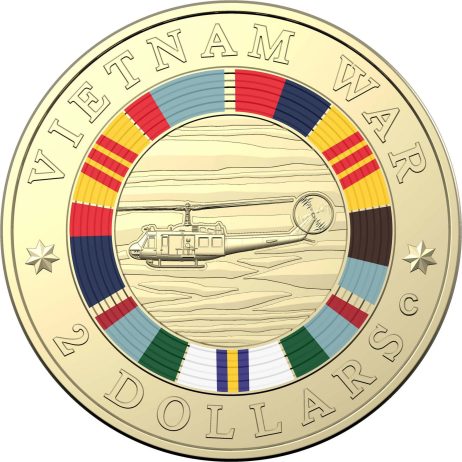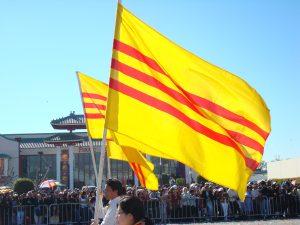Late last week, Vietnam’s government issued a complaint about the release of an Australian commemorative coin that shows the flag of the now-defunct government of South Vietnam. The incident was relatively minor, Australian media reports of a pending “diplomatic row” notwithstanding, but offered an important insight into the concerns and sensitivities of the country’s ruling Communist Party of Vietnam (CPV).
As SBS News reported on Friday, the Royal Australian Mint last month issued 85,000 sets of gold and silver $2 coins to mark the 50th anniversary of the withdrawal of Australian troops from the Republic of Vietnam (RVN), as the U.S.-backed southern government was officially known.
One side of the coin features a memorial portrait of the late Queen Elizabeth II, while the reverse side shows a UH-1 helicopter surrounded by a ring featuring the medal ribbons awarded to Australian veterans who served in Vietnam. Two of these incorporate the design of South Vietnam’s flag: a yellow field bisected horizontally by three red stripes.
Pham Thu Hang, a deputy spokesperson for the Ministry of Foreign Affairs, said on Thursday that Vietnam has discussed the matter with Prime Minister Anthony Albanese’s government and requested that the coins’ circulation be halted.
“We are regretful and strongly protest against the Royal Australian Mint and Australia Post’s releases of items with the image of the yellow flag of a regime that no longer exists,” Pham Thu Hang said in a report published in a local newspaper and translated by Radio Free Asia. “This is not in line with the tendency of fine developments of the Vietnam-Australia Strategic Partnership.”
The Royal Australian Mint responded with a terse statement in which it distinguished the South Vietnamese flag from the medals awarded to Australians who fought in its defense.
“The design of the coin reflects the colours of the ribbons of the service medals awarded to Australians who served in Vietnam, including the Vietnam Service medal, introduced in 1968,” the mint said in a statement. “The Australian Government does not recognize the flag of the former Republic of Vietnam.” This $2 coin was in fact not the first to feature the colors of the Saigon government’s flag; a commemorative 50-cent piece that was released in 2016 also included the offending red and yellow stripes.
Australia played a significant role in the Vietnam War, sending more than 60,000 troops to fight in the conflict, an effort that was hotly opposed by a vocal anti-war movement. A total of 523 Australians died and almost 2,400 were wounded, SBS reported, citing statistics from the Australian War Memorial. As John Murphy wrote in his 1993 book “Harvest of Fear: A History of Australia’s Vietnam War,” the conflict “was simultaneously Australia’s longest and most contentious war, and inevitably its echoes continue.”

The commemorative $2 coin was issued by the Royal Australian Mint to commemorate the end of Australia’s involvement in the Vietnam War. (Royal Australian Mint)
The truth of this was further underlined by Vietnam’s response to the relatively obscure release of commemorative coins. Hanoi’s sensitivity about the war probably has less to do with the memories of the war than with the fact that the RVN flag remains a symbol, albeit a fading one, of opposition to CPV rule. This is true both in viet kieu (overseas Vietnamese) communities, including in Australia, where the flag is still frequently flown, as well as in Vietnam itself. (Indeed, it is the potential connection between diaspora opponents and domestic dissidents that most worries the CPV’s securocrats.)
While the flag isn’t explicitly banned under Vietnamese law, the country’s authorities generally view its display as a form of sedition. In March 2016, a Vietnamese court sentenced three women who held up RVN flags to four years in prison on charges of spreading anti-state propaganda. Five people were convicted of the same charge the following year for displaying the flag on the April 30 anniversary of the fall of the RVN to the armies of the communist north, and four more in early 2018. All were sentenced to hefty prison terms.
While the incident speaks to areas of nationalist sensitivities in Vietnam, it is unlikely to derail the recent advances in the Vietnam-Australia relationship. As with the U.S., Australian relations with Vietnam have flourished in recent years, as the two nations have grown more concerned about China’s growing power and assertiveness, and the need to diversify away from their heavy economic dependence on it. Instead, “coingate” serves as a reminder of perhaps the overriding domestic concern of Australia’s new foreign partner: shoring up and strengthening the CPV’s monopoly on power.































